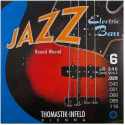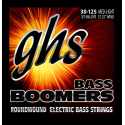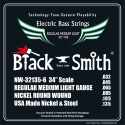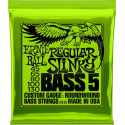New products
-

-

-

-

-

-

STAGG SG-A200BK Double guitar stand
- Height range: 60 to 70 cm/ 23.6 to 27.6 in- Neck forks with safety...
46,00 €
6 Strings
Subcategories
20-90
A set of strings for a 6-string electric bass with a range of 20-90 is a set of six steel strings specially designed for a six-string electric bass. The strings have different diameters and are tuned in B, E, A, D, G and C (lowest to highest).
The "draw" refers to the tension of the strings, i.e. the force needed to tension them to the right height. In the case of a set of strings for a 6-string electric bass with a tension of 20-90, this means that the lowest string (B) will have a tension of 20 pounds (about 9 kilograms) and the highest string (C) will have a tension of 90 pounds (about 40 kilograms).
The strings on an electric bass are important in determining the sound and playability of the instrument. Thinner strings tend to produce higher tones, while thicker strings produce lower tones. Six-string electric basses often have an extra string (the C string) over a standard four-string electric bass, which extends the range of the instrument.
In summary, a set of strings for a 6-string electric bass drawing 20-90 is a set of six steel strings designed for a six-string electric bass, with different diameters and tensions ranging from 20 to 90 pounds for each string. These strings are essential to produce the desired sound and playability of the instrument.
26-95
A set of strings for a 6-string electric bass with a draw range of 26-95 is a set of six strings designed to be used on a six-string electric bass, with a draw range of 26-95.
The draw of the strings refers to the thickness of the string and affects the tension of the string when tuned. Thicker strings have a higher tension and can have a deeper, more powerful sound, while thinner strings have a lower tension and can have a brighter, clearer sound.
A set of electric bass strings is often made from stainless steel or nickel wire, and may have a variety of coatings to help extend the life of the string and improve playability.
In general, bassists choose a set of strings based on their playing style, tone preference and preferred tension. A thicker set of strings may be preferred for a heavier sound or for bassists who use lower tunings, while a thinner set of strings may be preferred for a brighter sound or for faster, lighter playing.
27-126
A set of strings for a 6-string electric bass with a drawbar of 27-126 is a combination of six metal strings that are designed to be used on an electric bass with six strings. The numbers "27-126" refer to the individual string gauges, i.e. their diameter in millimeters.
The thickest strings in this set have a gauge of .126 mm, while the thinnest have a gauge of .027 mm. Intermediate strings range in size from .032 mm to .105 mm.
The thicker strings are generally used for the lower notes, such as the bass, while the thinner strings are used for the higher notes. The middle strings are used for the notes in between.
Metal strings produce a brighter, louder sound than nylon or gut strings. They can also be more difficult for beginners to play because of their higher tension. However, experienced bassists often prefer metal strings for their distinctive sound and durability.
Ultimately, choosing a set of strings for an electric bass depends on the musician's personal preferences and the style of music he or she plays.
29-118
A set of strings for a 29-118 gauge 6-string electric bass is a set of six strings designed specifically for use on a six-string electric bass. The 29-118 draw indicates the thickness and tension of the strings.
The term "draw" refers to the tension of the string and is measured in units of force in pounds (lb) or kilograms (kg). Higher draw means more tension on the string, which can affect the way the bass sounds and feels when played.
The strings in a set of strings for a 6-string electric bass with a draw range of 29-118 are numbered from thinnest (high E string) to thickest (low B string). The thicker strings are generally used to play lower notes, while the thinner strings are used to play higher notes.
When choosing a set of strings for your six-string electric bass, you should consider the style of music you play and your playing technique. Thicker strings are generally better for aggressive playing, while thinner strings are better for softer playing styles.
In summary, a set of strings for a 6-string electric bass drawing 29-118 is a set of six strings designed for use on a six-string electric bass, with specific thickness and tension to meet the players' needs in terms of tone and playing feel.
30-126
A set of strings for a 6-string electric bass drawing 30-126 is a set of six metal strings that are designed to be used on a six-string electric bass. Strings are generally classified by their gauge, which is determined by the thickness of the string. In this case, the strings range in gauge from 30 to 126.
String gauge can affect the sound and playability of the electric bass. Thicker strings tend to have a richer, deeper sound, but can be more difficult to play because of the higher tension required to make them vibrate. Thinner strings tend to have a brighter, clearer sound, but can be easier to play because of the lower tension required.
It is important to note that the strings must be compatible with the electric bass. Strings for a six-string bass cannot be used on a four-string bass and vice versa. Similarly, strings for a fretted electric bass cannot be used on a fretless electric bass and vice versa.
In summary, a set of strings for a 6-string electric bass drawing 30-126 is a set of six strings designed to be used on a six-string electric bass, with a gauge of 30-126, which can affect the sound and playability of the electric bass.
30-130
A set of strings for a 6-string electric bass with a range of 30-130 is a set of six metal strings designed to be installed on a six-string electric bass. The strings are graded by thickness and are often identified by the note of the lowest string (the B string in 6-string bass).
The strings in this configuration are thicker than those in 4-string basses because there are two extra strings that add lower notes. The strings are also tighter to accommodate the extra length of the bass neck.
The draw range of these strings is 30-130, which means that the thinnest string is 0.30 millimeters in diameter and the thickest string is 1.30 millimeters in diameter. The thicker strings produce a deeper, more powerful sound, while the thinner strings produce a higher, more delicate sound.
When choosing a set of strings for a 6-string electric bass with a draw range of 30-130, it is important to consider your playing style and tonal preferences. Thicker strings are better suited for heavier, more aggressive styles of music, while thinner strings are better suited for lighter, more subtle styles of music.
32-130
A set of strings for a 6-string electric bass drawing 32-130 is a set of six strings designed specifically for use on a six-string electric bass. The strings are graded by diameter and thickness, and are usually made from a material such as stainless steel, nickel or cobalt.
In the case of this set of strings, the number "32-130" indicates the range of string diameters. The thinnest bass string (the first string) has a diameter of 0.032 inches, while the thickest string (the sixth string) has a diameter of 0.130 inches.
The draw of the strings refers to the tension they exert on the neck of the bass. A set of strings with a higher drawbar requires more force to press the strings and produce notes, but can also provide greater sound projection and better string response. The draw of this set of strings is probably quite high because of the larger size of the bass and the need to produce low tones.
Ultimately, the choice of a string set for an electric bass depends on the musician's personal preference, playing style and the sound they are looking for.
32-135
A set of strings for a 6 string electric bass with a draw range of 32-135 is a set of six metal strings designed to be used on a six string electric bass with a specific draw range. The tension of the strings determines the ease of playing and the sound produced.
The first number in the drawbar (32) corresponds to the thickest bass string, and the last number (135) corresponds to the thinnest bass string. Thicker strings produce a lower tone and need more tension to be tuned, while thinner strings produce a higher tone and need less tension to be tuned.
Bass strings are usually made of nickel, stainless steel or other metal alloys. Thicker strings tend to have a longer life, but may require more time to "break in" and reach their optimum sound.
The choice of a set of strings depends on the bassist's personal preferences, the style of music played, as well as the characteristics of the instrument itself. It is important to choose a quality set of strings to ensure good intonation, dynamic response and optimal sound.
45-130
A set of strings for a 6-string electric bass drawing 45-130 is a set of six metal strings specifically designed for use on a six-string electric bass. The strings are named according to their diameter and lowest note, and can vary in composition, coating and tension.
The numbers "45-130" refer to the thickness of the individual strings in the set. The thinnest bass string has a diameter of 0.045 inches (about 1.14 millimeters), while the thickest bass string has a diameter of 0.130 inches (about 3.3 millimeters). String tension can also vary depending on the metal composition and thickness of the string, and can affect the playability of the bass.
Six-string electric basses offer a wider range of notes and tonal possibilities than four-string basses. The extra strings allow the bassist to explore lower frequencies as well as higher harmonics, which can be especially useful in certain styles of music such as metal, jazz-fusion or funk.
It is important to choose an appropriate set of strings based on your personal preferences for sound, playability and durability, as well as the style of music you play. Strings should also be replaced regularly to maintain optimal tone and playability.

A set of strings for a 6-string electric bass is a set of six strings of different thicknesses and lengths designed to be mounted on a six-string electric bass. Each string has a different note and a specific tension that allows it to produce a specific range of frequencies when plucked or strummed with the fingers or a pick.
Strings are usually made of steel or nickel alloy, although some manufacturers offer strings in other materials such as titanium or cobalt. Thicker strings produce lower notes, while thinner strings produce higher notes.
String sets for a 6-string electric bass are available in a variety of gauges, which refer to the thickness of the string in millimeters. Bassists can choose a specific string gauge based on their preferred playing style, tone preference and playing technique.
It is important to change the strings of an electric bass regularly to maintain good intonation, tone and avoid corrosion. 6-string electric bass string sets can be purchased in music stores or online from specialized string manufacturers.








